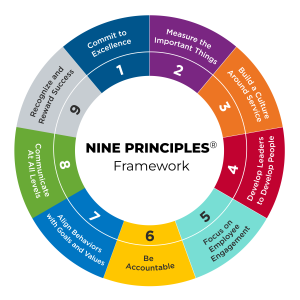
The Nine Principles® Framework: A Foundational Guide to Defining Organizational Excellence
Excellence isn’t accidental in any organization. It begins when leaders make a conscious decision to create conditions where excellence thrives. To be top-rated by people inside and outside of the organization, leaders must have a strong vision of what organizational excellence looks like and how to achieve it. Without leadership commitment, high performance may happen in pockets but doesn’t have a recognizable impact on the entire system. An organization may be great at recognizing employees but perhaps not so good at holding people accountable for outcomes. Or maybe employee engagement is top-rated, but leadership doesn’t have a defined set of measures that show success.
Summary
- The Nine Principles® Framework provides a systematic approach to defining and achieving excellence over time.
- Dive deeper into what each principle means and what it looks like in a high-performing organization.
- Each principle aligns with areas of the Malcolm Baldrige National Quality Award criteria and can be implemented as a foundational step to beginning a Baldrige journey.
What is the Nine Principles® Framework?

The Nine Principles Framework outlines the nine components of excellence that are consistently present in high-performing organizations. They are guiding principles that can be used to inform improvement work in any organization. These principles set the behaviors and expectations to create and sustain a culture of excellence where individuals choose to work and achieve at high levels. They provide a roadmap to help organizations develop a success-based culture using data or evidence to chart the course.
Principle 1: Commit to Excellence
Set high expectations to achieve results while living out mission and values.
Organizations that embody this principle have set values with key descriptors. Leaders are consistent in their practices, and senior leaders role model the values and behaviors expected for high performance.
Principle 2: Measure the Important Things
Continuously track progress to achieve results with an improvement mindset.
Results matter to the success of any organization. Leaders must objectively assess the current status and track progress toward goals. Measuring the important things means focusing outcomes on a well-balanced system and applying metrics to the core pillars for success.
Principle 3: Build a Culture Around Service
Serve others with great care and concern.
Building a culture around service means that organizational values are engrained in service to customers and team members. These organizations have clearly defined standards of service excellence. They consistently survey their customers and team to get feedback and improve service. In these organizations, it’s common to see peer staff training models focused on providing amazing service.
Principle 4: Develop Leaders to Develop People
Coach people to be their best at work.
Excellent organizations invest in leadership excellence. They hire top-performing leaders and develop the leadership skills of all employees. Decision-makers within these organizations support leadership development and intentionally build it into the development plan for all employees, recognizing that all people are leaders of their work.
Principle 5: Focus on Employee Engagement
Attend to aspirations and desires in the workplace.
There is a difference between satisfaction and engagement. Satisfaction is an internal feeling. Engagement, on the other hand, is marked by a set of behaviors that show that an employee is committed to their work and actively feels a sense of ownership and participation in goals and strategies. Leaders who are focused on engagement give employees opportunities for input, have regular conversations about expectations and performance, and recognize employees for their impact.
Principle 6: Be Accountable
Commit to individual accountability to achieve organizational goals.
Leaders should always have systems to hold people accountable for their goals, but in a high-performing workplace, the culture fosters an environment where engaged employees hold themselves accountable. They have an individual sense of responsibility to achieve results. In these organizations, employees have individual 90-day plans. They have input on their goals and how their goals will contribute to the overall goals of the organization.
Principle 7: Align Behaviors with Goals and Values
Apply consistent practices to move the organization in a positive direction.
Alignment is the hallmark of well-oiled systems and practices. A strong organization will have aligned actions and behaviors to goals. An excellent organization aligns goals with values so that the values of the organization are behind everything that people do. When behaviors and goals are aligned with values, it creates the conditions for transparency and builds trust. When you look into the systems and processes of organizations that do this well, you find resources dedicated to alignment, like an Evidence-based Leadership Scorecard and process improvement tools.
Principle 8: Communicate at All Levels
Help people know why what they do matters.
Effective communication at scale starts with the why and then describes the what and how. Some people communicate this way naturally, but for some, it takes intentional practice. In high-performing organizations, leaders pause to plan communication, considering the audience and the important information to be conveyed. This practice is consistent across leadership, especially when communicating changes, big decisions, or difficult news. Communication shifts from reactive to proactive and is viewed as more than a means to relay a message. Leaders in excellent organizations know that communication is at the heart of strong working relationships.
Principle 9: Recognize and Reward Success
Value and appreciate people working together to get results.
What gets recognized gets repeated. That’s why in organizations that excel, reward and recognition is used for more than employee engagement. When leaders pause to celebrate the wins behind progress, intentionally pointing out the people and actions that contributed to those wins, they communicate to the entire team actions that merit following. Recognizing and rewarding success ensures that great work doesn’t go unnoticed and that employees understand what right looks like.
The Nine Principles Framework® and the Malcolm Baldrige National Quality Award
The Malcolm Baldrige National Quality Award is awarded by the United States Congress to organizations that exhibit superior management and earn the presidential honor for performance excellence. Award recipients are assessed in seven categories:
- Leadership
- Strategy
- Customers
- Measurement, Analysis, and Knowledge Management
- Workforce
- Operations
- Results
Each principle aligns with one or more of the Baldrige performance excellence criteria. Consistently implementing the tools and practices to achieve each principle is a foundational step to building the framework for an organization’s Baldrige excellence journey. An organization that applies the Nine Principles Framework well will discover that they are already implementing practices to meet areas of the Baldrige criteria.
Alignment of the principles and the Malcolm Baldrige Award
| Criteria 1: Leadership | Criteria 2: Strategy | Criteria 3: Customers | Criteria 4: Measurement, Analysis, and Knowledge Management | Criteria 5: Workforce | Criteria 6: Operations | Criteria 7: Results | |
|---|---|---|---|---|---|---|---|
| Principle 1: Commit to Excellence |
X | X | X | ||||
| Principle 2: Measure the Important Things |
X | X | X | X | |||
| Principle 3: Build a Culture Around Service |
X | X | |||||
| Principle 4: Develop Leaders to Develop People |
X | X | |||||
| Principle 5: Focus on Employee Engagement |
X | ||||||
| Principle 6: Be Accountable |
X | X | X | ||||
| Principle 7: Align Behaviors With Goals and Values |
X | X | |||||
| Principle 8: Communicate at All Levels |
X | X | X | ||||
| Principle 9: Recognize and Reward Success |
X | X |
KEY TAKEAWAYS
Using the Nine Principles Framework for Organizational Excellence to guide improvement, leaders can:
Think differently.
Commit to excellence as a first step to organizational transformation.
Plan differently.
Start with an assessment of the organization for each of the principles and use that assessment to identify the few areas to work on first.
Act differently.
Approach improvement and the Nine Principles Framework as a cyclical and ongoing implementation to reach goals and consistently improve performance.





